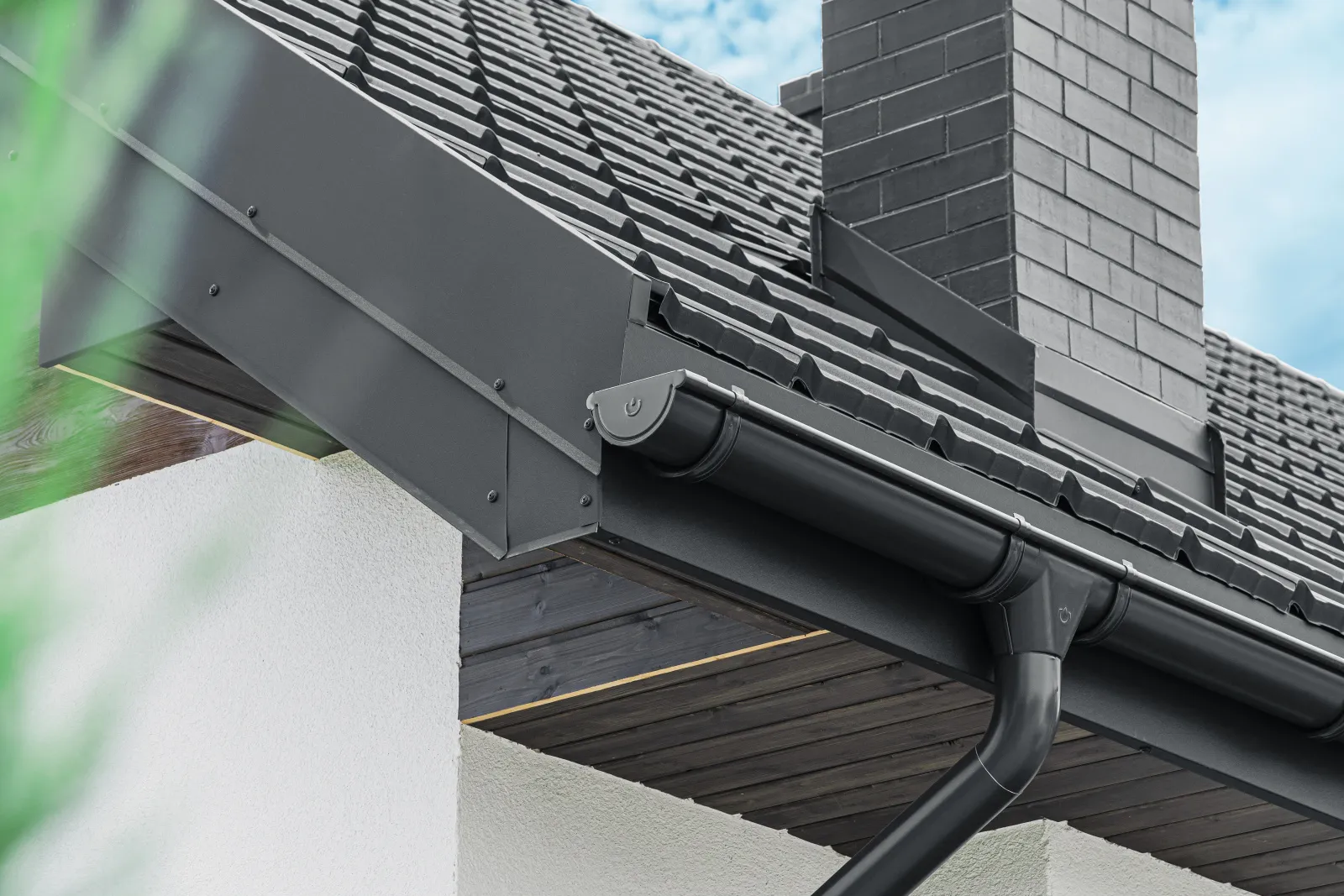Which gutters should you choose for a single-family house?

Types of gutters for a single-family house
It is worth considering the choice of a guttering system already at the design stage, because not every solution can be applied in an existing building. An example would be eavesless systems, where the guttering is hidden beneath the façade and therefore invisible. Since such systems are used for draining water from roofs without eaves extending beyond the façade, they require special system solutions.
Which guttering system to choose for your house?
More traditional guttering systems, where gutters and downpipes are visible, can be used in almost any building topped with a roof with eaves. Before deciding which gutters to choose, it is useful to know what options are available – particularly in terms of the materials currently used for gutters and downpipes in single-family houses.
Which gutter materials are best for a house?
Homeowners most often choose between steel gutters and PVC gutters. However, there are also other solutions, such as copper gutters and aluminium gutters, which are less popular for various reasons. What are the pros and cons of each system?
PVC gutters
PVC gutters are the most affordable option. They are made from polyvinyl chloride, which is coloured during production. To increase their resistance to UV radiation, manufacturers add special compounds – yet with strong exposure to sunlight, discolouration may still occur over time.
Their biggest advantages are that they require no maintenance, are corrosion-resistant, easy to install, lightweight, resistant to impact and scratching, and therefore ideal for houses surrounded by trees whose branches could damage the guttering. Thanks to their smooth surface, they are less likely to become clogged with leaves or twigs.
Due to their lower resistance to deformation at high temperatures, producers use special additives in the PVC mixture and install EPDM rubber seals in fittings to prevent leaks.
Steel gutters
Steel gutters are a more expensive alternative to plastic. They are resistant to both high and low temperatures. The higher cost comes not only from the material itself, but also from the more demanding installation, which requires experience and therefore increases service costs.
Steel gutters are made with a layered construction – a steel base coated with zinc and additional protective layers to increase corrosion resistance. Their advantages include high impact resistance and rigidity, which prevents deformation under the weight of snow or ice.
The downside is their susceptibility to corrosion in areas where the surface is scratched or damaged. For this reason, regular maintenance and inspection of protective coatings are necessary.
Aluminium gutters
Made from aluminium-manganese sheet, these gutters are coated on both sides with paints containing synthetic materials such as polyester, which prevent darkening. Their advantages include a very smooth surface and long lifespan. They are available either as prefabricated elements or produced on site.
Copper gutters
Due to their high price, copper gutters are rarely chosen. However, their durability – estimated at up to 300 years – is impressive. Their biggest advantage is corrosion resistance without the need for maintenance. This is thanks to the natural formation of copper oxide, and later patina, which protects the material. Copper gutters are also highly resistant to mechanical damage and temperature fluctuations.
The downside is that copper reacts with aluminium and steel, so it cannot be combined with those materials. They are therefore best suited for copper roofs or ceramic tiles.
What gutter size should you choose for a house?
To properly select gutter size, you need to calculate the so-called effective roof area (EPD), i.e. the surface requiring drainage. The steeper the slope, the greater the EPD.
Manufacturers often make the task easier by providing tables, calculators and recommendations for dimensions, quantities and placement of gutters and downpipes according to the effective roof area.
The formula for roofs with a slope greater than 10° is:
Effective roof area = (W + ½H) × L
- W = horizontal distance from the roof edge to the ridge
- L = roof length along the eaves
- H = roof height
For roofs with a slope of less than 10°, the effective roof area equals the roof area itself.
Despite calculators and tables, it is always wise to consult specialists who will handle installation, as online tools may not account for all variables, such as complex roof shapes.
How to estimate guttering costs
The larger the roof, the higher the guttering cost – this is obvious. However, roof shape also plays a role. Roofs with multiple slopes require more gutters and downpipes, which significantly increases expenses compared to a simple gable roof.
For example, a roof perimeter of 70 metres will require about 70 metres of gutters, while a multi-slope roof of the same size may need up to 30% more due to gables requiring additional guttering.
Once you know how many metres of gutters are needed, you can easily calculate the cost using the manufacturer’s price per metre. To this, you must add the cost of accessories such as brackets, corners, hooks, etc. As this requires precise knowledge of the quantities needed, it is best to consult the manufacturer and provide technical drawings for an accurate quote.
What to consider when choosing gutters for a single-family house
When choosing gutters for a house, durability and resistance to local conditions are key – for example, resistance to salt in the environment or proximity to tall trees. The manufacturer also matters: investing in a guttering system is a long-term decision, so it is best to choose a supplier with proven experience. This ensures easier access to spare parts in the future if repairs are needed.
Which gutters should you choose for a single-family house? summary
The roof covering and matching guttering are among the most visible elements of a building’s structure. It is therefore no surprise that aesthetics often play a major role in decision-making. However, when considering which gutters to choose for a single-family house, it is also important to factor in cost, the material used, and the reliability of the manufacturer.
